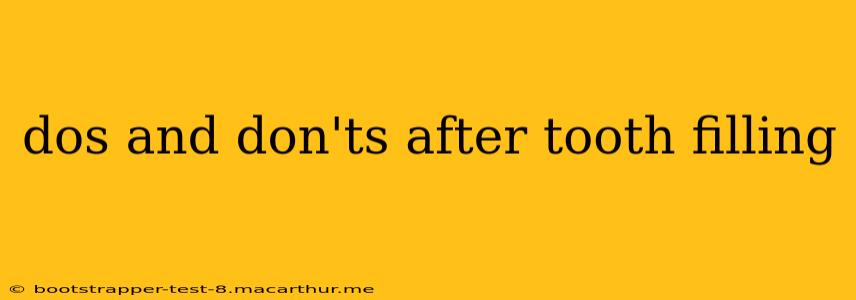Getting a tooth filling is a common dental procedure, but proper aftercare is crucial for ensuring a successful outcome and preventing complications. This guide outlines the essential dos and don'ts following a tooth filling, helping you maintain optimal oral health.
What to Do After a Tooth Filling
Following your dentist's instructions carefully is paramount. However, here are some general dos to prioritize after receiving a filling:
1. Manage Pain and Swelling:
- Take prescribed medication: If your dentist prescribed pain relievers, take them as directed to manage any discomfort. Over-the-counter pain relievers like ibuprofen can also help.
- Apply cold compress: A cold compress applied to the cheek near the affected area can help reduce swelling and alleviate pain. Apply for 15-20 minutes at a time, several times a day.
2. Maintain Oral Hygiene:
- Gentle brushing and flossing: Resume gentle brushing and flossing as soon as you feel comfortable, typically after the initial numbness wears off. Be extra gentle around the filling area to avoid dislodging it.
- Rinse with saltwater: Gently rinse your mouth with warm salt water (1/2 teaspoon salt in 8 ounces of water) several times a day to help keep the area clean and promote healing. Avoid vigorous rinsing.
3. Monitor for Complications:
- Watch for infection signs: Be vigilant for signs of infection such as persistent pain, swelling, redness, or pus around the filling. Contact your dentist immediately if you experience any of these.
- Check the bite: Pay attention to how your teeth bite together. If you notice any unusual high spots or discomfort when biting, contact your dentist.
4. Follow Your Dentist's Instructions:
- Dietary restrictions: Your dentist might recommend avoiding certain foods for a period after the filling. This usually includes very hot or cold foods and sticky or hard candies that could put pressure on the filling. Follow their recommendations carefully.
- Follow-up appointments: Attend any scheduled follow-up appointments to ensure the filling is healing properly and there are no complications.
What NOT to Do After a Tooth Filling
Avoiding these actions is crucial for the longevity and success of your tooth filling:
1. Avoid Certain Foods and Drinks:
- Extremely hot or cold foods and drinks: These can cause sensitivity and discomfort in the treated area. Stick to lukewarm foods and drinks for at least 24 hours.
- Sticky or hard foods: Avoid sticky candies, chewing gum, and hard foods that could dislodge the filling.
- Foods that stain teeth: Be mindful of consuming foods and drinks that could stain your teeth, as they might have a greater effect on the area of the new filling, at least in the first few days.
2. Refrain from Harmful Habits:
- Smoking: Smoking can interfere with healing and increase the risk of infection. Quitting smoking is beneficial for overall oral health.
- Grinding your teeth: Bruxism (teeth grinding) can put extra stress on the filling and potentially damage it. If you grind your teeth, consider using a mouthguard at night.
3. Delaying Treatment of Complications:
- Ignoring pain or discomfort: Don't ignore persistent pain, swelling, or other signs of complications. Contact your dentist immediately if you experience any issues.
4. Don't Use Over-the-Counter Fillings:
- Avoid DIY remedies: Do not attempt to fix the filling yourself using over-the-counter materials. This could cause further damage and complicate the situation.
Frequently Asked Questions (FAQ)
H2: How long does it take for a tooth filling to fully heal?
The healing time varies, but most people experience significant improvement within a few days to a week. Complete healing may take several weeks, depending on the size and location of the filling.
H2: Can I brush and floss normally after a filling?
Yes, but gently. Be extra careful around the filling site to avoid dislodging it. Start gently and gradually increase the pressure as you feel more comfortable.
H2: What should I do if my filling falls out?
If your filling falls out, contact your dentist immediately. Do not attempt to put it back in yourself.
H2: Why is it important to avoid extremely hot or cold foods and drinks after getting a filling?
Extreme temperatures can cause sensitivity in the treated tooth, which is common after a filling. The sensitivity usually subsides within a few days or weeks, but avoiding extremes initially can reduce discomfort.
H2: Can I exercise after getting a tooth filling?
Generally, yes, you can exercise after getting a tooth filling. However, avoid strenuous activities that could lead to jarring impacts to the head or mouth, especially immediately after the procedure, while your mouth is still numb.
By following these dos and don'ts and seeking prompt attention for any complications, you'll maximize the chances of a successful and long-lasting tooth filling. Remember that this information is for general guidance only and should not replace the advice of your dentist. Always consult with your dental professional for personalized aftercare instructions.
